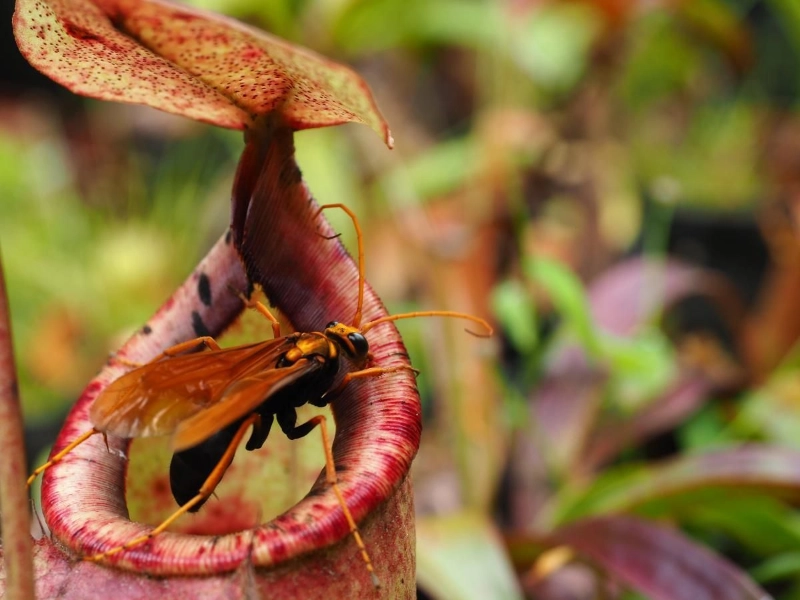The Eight Weirdest and Coolest Flowers in the World
Advertisement
8. Pitcher Plant: Nature's Living Pitfall Trap

Advertisement
Among all the carnivorous plants, pitcher plants—from the families Nepenthaceae and Sarraceniaceae—are among the most strikingly beautiful and mechanically complex ones. For millennia, botanists, entomologists, and nature lovers have been enthralled with these amazing species' unusual trapping method. Found all throughout the world, including Southeast Asia, Australia, and the Americas, pitcher plants have evolved to flourish in nutrient-starved conditions by augmenting their diet with insects and other tiny animals.
As its name implies, pitcher plants have a particularly unique characteristic: their pitcher-shaped leaf alteration acts as their trapping mechanism. These pitchers—also referred to as pitfall traps—are basically deep cavies at the bottom filled with a pool of digestive fluid. The pitcher's construction is a wonder of evolutionary design; every component is absolutely essential for the predatory strategy of the plant.
Often brilliantly coloured and producing nectar, the pitcher's top section—known as the peristome—helps to draw insects. Usually slick and waxy, this rim makes it challenging for insects to stay on. Once an insect starts to slide, certain species have downward-pointing hairs or ridges on the peristome, therefore further impeding its capacity to escape. The pitcher's inside walls are quite smooth beneath the peristome, usually covered in wax crystals that stop insects from acquiring any purchase.
Once an insect drops into the pitcher, it comes upon the liquid pool at the bottom. This fluid is more than just water; it's a complex combination of digesting enzymes and other plant-generated molecules. Although the makeup of this fluid differs between species, usually it consists of proteases, phosphatases, and other enzymes able to breakdown insect soft tissues. In order to help digestion, certain pitcher plants also feature colonies of bacteria and other microbes in their fluid.
Pitcher plants' adaptations beyond their simple means of capture. Many species have evolved lids or caps over their pitchers for several uses. In some circumstances, these lids serve as extra attractants for animals; else, they help prevent precipitation from diluting the digestive secretions and control the humidity inside the pitcher. Certain pitcher plants have even developed symbiotic ties with some animals. For instance, several species of Nepenthes offer bats or tree shrews refuge; their droppings are a source of nutrients.
Pitcher plants show amazing variety in colour, form, and size. Known to trap tiny creatures like rats, Nepenthes rajah is the biggest known pitcher plant able to contain up to 3.5 litres of fluid. Conversely, some of the tiniest pitcher plants create traps hardly a centimetre in length. This variation captures the several ecological niches these plants have evolved to occupy.
Carnivory in pitcher plants is believed to have evolved as a response to nutrient-starved conditions, especially nitrogen-starvation. Pitchter plants can flourish in environments where other plants suffer by augmenting their food intake with insects and other tiny creatures. From tropical rainforests to temperate bogs, this adaption has let them colonise a vast spectrum of surroundings.
Apart from their environmental importance, pitcher plants have long been part of human civilisation and conventional medicine. various areas of Southeast Asia use various Nepenthes species' pitchers as naturally occurring cooking pots or water containers. Though the effectiveness of these medicines is not supported by science, certain indigenous tribes have employed pitcher plant extracts in traditional remedies.
Scientists still find great interest in pitcher plants. Research on the makeup of their digestive juices has produced new enzymes with possible use in biotechnology. Pitchter plants' slick surfaces have motivated study on novel anti-fouling compounds. Furthermore offering insightful analysis of community ecology and evolution are the intricate ecological interactions between pitcher plants and their prey as well as the microorganisms residing in their traps.
Given habitat destruction, over-collecting for the horticulture trade, and climate change, conservation of pitcher plants is becoming increasingly important for many species. In their natural environments certain animals are highly endangered. Protecting these rare species usually calls for habitat protection, cultivation initiatives, and trade and collection policies control.
In the field of horticulture, pitcher plants have become somewhat popular as unusual and fascinating additions to specialised gardens and greenhouses. But for inexperienced gardeners, their particular care needs—which sometimes include high humidity, pure water, and specialised soil—can be difficult.
Finally, one of nature's most clever answers to the difficulty of getting nutrients in hostile conditions are pitcher plants. Not only are they intriguing topics of research, but their intricate trapping systems, varied adaptations, and ecological relevance also contribute significantly to the habitats they call home. These amazing plants remind us of the amazing variety and adaptability of life on Earth as we work to solve their riddles.
You May Like
Advertisement

